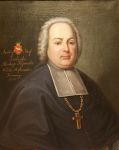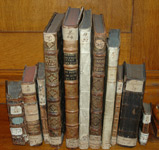Brief History of the Collection
History of the Imperial Public Library since its founding is inextricably linked to the famous ZaŇāuski Library.

 The ZaŇāuski Brothers' book collection began to form from the personal library of Chancellor of the Crown and Bishop Andrzej ZaŇāuski Chrysostom at the turn of the 17th-18th centuries. After his death, the library was inherited by his nephews Andrzej Stanislaw (1695-1758) and Jozef Andrzej (1702-1774).
The ZaŇāuski Brothers' book collection began to form from the personal library of Chancellor of the Crown and Bishop Andrzej ZaŇāuski Chrysostom at the turn of the 17th-18th centuries. After his death, the library was inherited by his nephews Andrzej Stanislaw (1695-1758) and Jozef Andrzej (1702-1774).
The ZaŇāuskis – known Polish scholars and church leaders. The younger brother Jozef Andrzej undertook the task to collect the universal collection of books for the Polish scientific community and dedicated his life to this aim. He bought books abroad, found them in the monasteries, ordered handwritten copies.
 Since 1747 the library became public by the decision of the owners. Its grand opening was held on August 8, 1748 in the presence of King Augustus II at the Danilowicz Palace in Warsaw, specially acquired for the collection by Andrzej Stanislaw ZaŇāuski. After the death of the last owner Jozef Andrzej ZaŇāuski in 1774, the library became a state institution.
Since 1747 the library became public by the decision of the owners. Its grand opening was held on August 8, 1748 in the presence of King Augustus II at the Danilowicz Palace in Warsaw, specially acquired for the collection by Andrzej Stanislaw ZaŇāuski. After the death of the last owner Jozef Andrzej ZaŇāuski in 1774, the library became a state institution.
In the 18th century, the ZaŇāuski Brothers' book collection was considered to be one of the largest private libraries in Europe with over 400,000 publications, 40,000 prints and about 20,000 manuscripts. The collection of books was so valuable that, after the suppression of the KoŇõciuszko Uprising in November 1794 and the third partition of Poland, Catherine II ordered to send it from Warsaw to St. Petersburg as a major trophy.
 When, in June 1795, the ZaŇāuski Library was delivered from Warsaw to Saint Petersburg, no one could imagine what impact this rich collection of books would have on the development of culture and education of the Russians. This event prompted the government to speed up the construction of a special building for a public library, a plan for founding which was submitted by Count Stroganov to the Empress as far back as 1766. After the construction was completed in 1801, the ZaŇāuski Brothers' collection was transferred to a new building and laid the cornerstone of the Imperial Public Library..
When, in June 1795, the ZaŇāuski Library was delivered from Warsaw to Saint Petersburg, no one could imagine what impact this rich collection of books would have on the development of culture and education of the Russians. This event prompted the government to speed up the construction of a special building for a public library, a plan for founding which was submitted by Count Stroganov to the Empress as far back as 1766. After the construction was completed in 1801, the ZaŇāuski Brothers' collection was transferred to a new building and laid the cornerstone of the Imperial Public Library..

 According to the Register of Manuscripts, preserved in the National Library of Russia, the guardian of ¬ęDepot of Manuscripts¬Ľ P. Dubrovsky accepted 11,010 manuscript volumes from the ZaŇāuski collection in 1806-1807. However, the ZaŇāuski Library has not survived as a single collection: the printed book were dispersed throughout various holdings, and the manuscripts came in the ¬ęDepot of Manuscripts¬Ľ. In the 40s of the 19th century, during the reorganization of the library, the ZaŇāuski Brothers' manuscripts were rearranged and included in the new inventories by their language, so they were interspersed with the items from other collections and were placed in different bookcases.
According to the Register of Manuscripts, preserved in the National Library of Russia, the guardian of ¬ęDepot of Manuscripts¬Ľ P. Dubrovsky accepted 11,010 manuscript volumes from the ZaŇāuski collection in 1806-1807. However, the ZaŇāuski Library has not survived as a single collection: the printed book were dispersed throughout various holdings, and the manuscripts came in the ¬ęDepot of Manuscripts¬Ľ. In the 40s of the 19th century, during the reorganization of the library, the ZaŇāuski Brothers' manuscripts were rearranged and included in the new inventories by their language, so they were interspersed with the items from other collections and were placed in different bookcases.
The manuscripts from the ZaŇāuski Brothers' collection had remained in Russia until the early 1920s and then were returned to the Republic of Poland under the terms of the Treaty of Riga dated to 18 March 1921.
Events of the Second World War was disastrous for the ZaŇāuski Library. It has suffered the fate of the richest collection of ancient times - the Library of Alexandria. In August-September 1944, it was almost entirely lost in the fire, deliberately destroyed by German troops. Only 12 percent of the famous collection of manuscripts has survived: 1851 items — in Warsaw and about 300 codices — at the National Library of Russia in St. Petersburg.
For the first time, the National Library of Russia provides an opportunity to all interested persons to get acquainted with the most interesting handwritten books from the ZaŇāuski Brothers' collection, preserved in our holdings. 29 manuscripts of the 9th-18th centuries in European and Oriental languages reflect the richness and scope of the ZaŇāuski Library.
 Because the ZaŇāuski Brothers belonged to higher clergy, Bibles, liturgical manuscripts and writings on theology were the most widely represented in their library. A significant part of the manuscript collection consists of the 16th-18th centuries books on the history of Poland and on jurisprudence, treatises on ecclesiastical and civil laws, medical and mathematical manuscripts, works of historical and literary genres. In the manuscripts collection of the ZaŇāuski brothers were about 20 codices in Oriental languages and almost no Russian manuscripts. Only 4 manuscript in Russian have been found among the surviving ZaŇāuski handwritten books so far.
Because the ZaŇāuski Brothers belonged to higher clergy, Bibles, liturgical manuscripts and writings on theology were the most widely represented in their library. A significant part of the manuscript collection consists of the 16th-18th centuries books on the history of Poland and on jurisprudence, treatises on ecclesiastical and civil laws, medical and mathematical manuscripts, works of historical and literary genres. In the manuscripts collection of the ZaŇāuski brothers were about 20 codices in Oriental languages and almost no Russian manuscripts. Only 4 manuscript in Russian have been found among the surviving ZaŇāuski handwritten books so far.
Belonging of books to the ZaŇāuski Library can be identified from their owner's records, stamps and notes revealed that the book was from the ZaŇāuski Library. Due to inscriptions and notes, it was established that the owners of several manuscripts, prior to their acquisition by the ZaŇāuskis, were major public figures and representatives of the European ruling dynasties: the French Kings Henry II and Henry III, Queen Anne of Austria, Duke of Burgundy Philip the Good, the last King of the Polish‚ÄďLithuanian Commonwealth Stanislaw August Poniatowski.